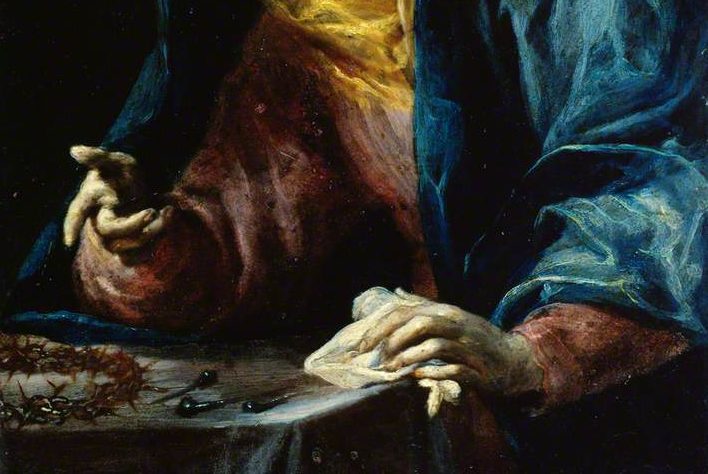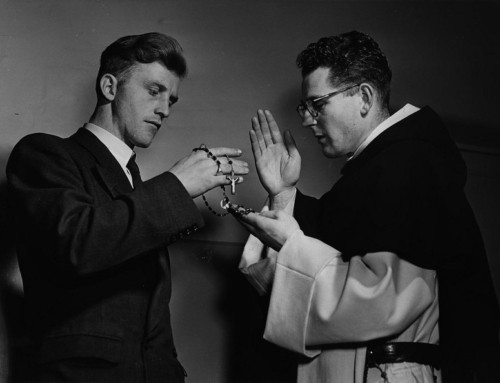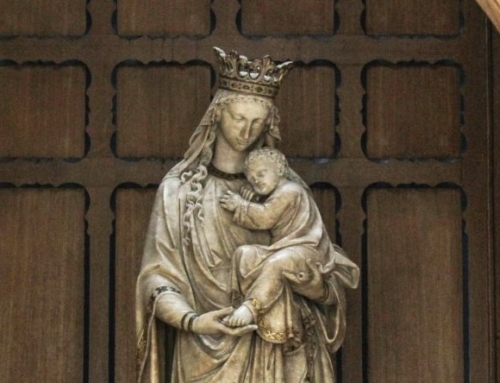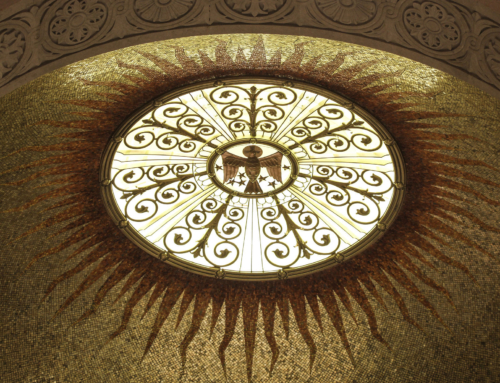Pierre-Thomas Dehau, O.P. (1870–1956) — Joie et tristesse
Biography
Pierre-Marie Dehau was born in 1870 in the town of Bouvines in northern France, the oldest of ten children. A gifted musician and a brilliant student, he perceived a call to the priesthood and entered the seminary at the age of eighteen. Not long after his ordination in 1894, he was sent to Fribourg, Switzerland, to study theology with the Dominican friars. In 1896, he entered the Order of Preachers as a son of the Province of France, taking his religious name, Brother Thomas, after St. Thomas Aquinas. On account of an illness during his youth which left him partially blind, he wrote no books: his writings that come down to us today are in fact notes taken during his sermons, which he then reviewed and corrected. Despite this physical limitation he preached extensively, especially on the spiritual life, teaching that contemplation, far from being reserved only for those in religious life, is for all Christians. From a young age, he always had a lively devotion to Our Lady, who featured prominently in his preaching and, as a result, in his writings: he saw in her the model for all contemplatives, and therefore also the greatest theologian. His homilies preached in various churches in Paris attracted many young intellectuals, including Jacques and Raïssa Maritain, to whom he became a revered and well-loved spiritual father or “providential guide,” as Jacques Maritain once referred to him. In addition to his countless conferences to laypeople, he also preached retreats to monasteries of nuns and other religious communities. In 1946 he became chaplain to the Dominican monastery in his hometown of Bouvines, where he preached frequent conferences to the nuns and gave spiritual counsel to many others, laypeople and religious alike, who sought his wisdom in the tumultuous aftermath of the Second World War. In 1956, after suffering greatly in his final years, frère Pierre-Thomas Dehau, O.P., died a peaceful death, surrounded by the nuns’ chants and prayers. The following is a translation of a chapter of his book, Joie et tristesse (Paris: Éditions du Cerf, 1945, pp. 101–116), which was likely compiled from a retreat he preached to a community of nuns in 1940.
Earthly Life, Mélange of Joy and Sadness
Now that we have tried [in the preceding conferences] to fathom the doctrine of joy with its principal Christian—and especially Eucharistic—consequences, let us enter into a still more puzzling complexity, the chiaroscuro of lived life. Let us listen to the claims and look at the facts. Let us try to distinguish and understand, to disentangle and differentiate the nearly indiscernible features of joy and sadness that get jumbled together and often seem to become confused in reality.
Just how complex this is can be shown by the extreme diversity—sometimes going as far as contradiction—of the judgments worldly men pass on true Christians. Some proclaim the happiness of these Christians, others their misfortune. And sometimes the same people move from one of these themes to the other, according to circumstances or impressions.
How are we, in our turn, to judge these unstable judgments of the world? There are some firm points we can rely on. In general, what makes worldly men happy tends to make Christians unhappy, because they discover false joys there. They have the intimate experience of tasting ashes in fruits that are marvelous in appearance and whose mere aspect charms and attracts worldly men. This is why Christians and worldly men so badly suffer, and make each other suffer so, when they are forced to live too close, too mixed together, almost on top of each other. They are like harsh and painful contacts between elements that violently collide, and are yet more violently repelled. The resulting bruises are not merely superficial; they risk penetrating even to the depths of their hearts and pulling them further and further apart. We see sad examples of this even in the family, even between spouses and between children and parents. Here we do not say the same thing about friends, however, because friendships, being less constrained, are more quickly split up and destroyed in cases like this, unless the Christian friend has the sometimes heroic courage to remain committed to his friend despite everything, and to strive to salvage the friendship, to transpose it, or at least to adjust it and improve it imperceptibly. Then something happens that resembles what St. Paul tells us about the faithful wife redeeming an unfaithful husband (1 Cor 7:13–14).
If we are to appreciate these things rightly we must also take into account a debate that is certainly not new; indeed, it already fills the book of Job. Scandalous to the worldly—and even disturbing to many others—are those trials that are not only harsh but sometimes even harder to bear than the ones with which God himself seems regularly to distress his own. If we want to avoid being scandalized by this ourselves, we must always remember with all our strength that God wants these afflicted souls to be saints, and to become saints as quickly as possible. But one can only become a saint—and do so quickly, especially—by heavy crosses, the weight of which can only be borne by a growing love, amor meus, pondus meum (“my love is my weight,” St. Augustine, Confessions XIII.9). If this wonderful phrase is able to lift and carry such a heavy weight, it is because love is itself like a divine heaviness, which not only balances all other burdens, but reigns and triumphs over them even as it gradually develops and grows. The world sees the cross, we may also say, but it does not see the hidden anointing by God, which not only teaches all things, unctio docebit vos omnia (1 Jn 2:27), but makes the Lord’s yoke—so heavy for eyes of flesh—light, and envelops it in inexpressible sweetness, jugum meum suave est et onus meum leve (“my yoke is easy and my burden light,” Matt 11:30). This lightness can become so great, so marvelous, that, even overburdened with the most crushing weight, it attracts us and carries us on high, following our heart elevated by love: sursum corda. Trahe me post te (Song 1:4). Draw me toward you and after you! How could the divine love fail to do so, when poor human love already manages to soar above every obstacle by the deep strength that is in it, with what Shakespeare calls “love’s light wings.”
This crushing weight of the cross, as worldly men notice, becomes a small thing for the Christian who is carried by the divine strength of love, carried away by the wings that he continually asks for and that God gives him, quis dabit mihi pennas et volabo (“If only I had wings . . . that I might fly away,” Ps 55:7). His love is at once his heaviness, pondus meum, and his supernatural lightness. But it is especially when he compares the earth with heaven, with that immense weight of glory which St. Paul speaks of and which must never come to an end, that all the crushing burdens of the earth appear to him as fleeting and light, momentaneum et leve (2 Cor 4:17). There are some desires without joy, because they do not know how to become hope; but every hope, especially that of the Christian, is already joy, spe gaudentes (“rejoicing in hope,” Rom 12:12). To the Christian, eternal life is entirely present, entirely loved, and therefore entirely joyful. His progress in the virtues, especially those that call for and bring about divine contemplation, the beginning of beatitude, makes him converse in heaven more than on earth, conversatio nostra in coelis est (“our conversation is in heaven,” Phil 3:20 Vulg.). In heaven only joy enters in.
Finally, we must add that God permits or wills these contrasts, so jarring and sometimes so violent, in order to avert the gaze of worldly men from the intimate works of his heart and his right hand. He wills that these works ever remain to them completely sealed and impenetrable. But for those whom he himself introduces into his secrets, he reserves enough light to admire their beauty and to receive and taste their teachings. He also reserves for them a share of mystery and darkness, that their faith might grow and be tested. This share of darkness often seems to us very great, especially if we compare it to the extreme sparingness with which light is granted us. But everything is explained by the fact that we are so often rebuked in the Gospel for being nothing but men of little faith: this is what prevents us from understanding the primordial importance of that very faith.
God only builds on faith, supra firmam petram (“upon a firm rock,” see Matt 7:25 and Ps 40:3). Faith is not only the base of his works, but it is often like their whole material, which we alone can supply him because we alone can practice the virtue of faith—even in our humanity, our Lord could not practice it. He always finds that, though he can only find this necessary material in us, we never supply him enough, in neither quantity nor quality. He declares us to be of little faith; and we ourselves, when we dare to say credo, must add, if we really know ourselves for what we are: “Lord, help my poor unbelief. Credo Domine, adjuva incredulitatem meam (Mk 9:24). I believe, Lord, I believe with all my heart, with all my strength: but the little faith to which I so arduously rise, compared with what it should be, with what it could become with the help of your grace—this little faith barely emerges from unbelief. The miserable mélange that I offer you, does it not often deserve to be called unbelief rather than faith?” Hence the necessity that God—as much in our interest as in that of his works, since they are based uniquely on faith, as is our whole personal Christian life—continually undertake to build up the quantity and strengthen the quality of our faith. And blessed be the trials, however hard they may seem to us, that convey us little by little to this progress, on which everything in us and around us depends! The world cannot understand anything of this rich account of the trials of believers, because the world almost entirely lacks the notion of faith and especially of its necessity. On the contrary, the Christian, led by these trials along dark paths to the more and more precise vision of these two notions, finds one of his greatest joys, that of experiencing this faith develop and grow in him, this faith which is the whole root of his supernatural life: Justus ex fide vivit (“the one who is righteous by faith will live,” Rom 1:17, Hab 2:4).
If, then, we search for the central feature in the harmonies and contrasts that the Christian life offers on this earth, we must not be amazed at the perpetual response of St. Thomas: this central feature is joy. Whatever shadows or sadness or dissonances rise up from below, it remains always radiantly clear that God is the final end, and that God can only be joy, pure and unalloyed.
For the created spirit, when it is not united to any matter and when it has been faithful to God, there can be only joy. It is indeed necessary that all created spirits be tried, in order to be elevated to the supernatural order and abide in intimacy with God. The pure spirit cannot be tried without that punitive suffering that is only conceivable as a consequence of sin; this was so also for man in the condition of original justice. Sin had to enter first; death and suffering could only enter after, subintravit mors (Wis 2:24; cf. Rom 5:12). And alas!—sin came, it entered in, it took hold in us, whence the current reign of death and suffering. It is by them that our trial continues: it is by the suffering that must last unto death, even death on a cross, usque ad mortem, mortem autem crucis (Phil 2:8). The shadow and light of the cross now extend over our whole path. The cross is the pillar of cloud, a mélange of brightness and darkness, which goes before us: this is what truly matters, and we need only follow it to the end. It is given to us as the necessary, and therefore unique, means. Ave spes unica (“behold, our only hope”) . . . in me omnis spes vitae et virtutis (“in me is all hope of life and of virtue,” Sir 24:25 Vulg.). The strength to walk the path, and the path itself—all is given to us by the one cross. We must hope in it, and we cannot but hope in it. You who enter into this royal way, voi ch’intrate, abandon all other hope.
Consequently, for the man in Eden—as always, and especially, for the angels—trials do not yet entail the mystery of suffering and of the cross. But ever since the Fall, the mystery of the cross shines and radiates on everything, fulget crucis mysterium. It is the standard of the great King, himself crucified, vexilla Regis prodeunt—it is this standard that advances before all; no path is sure, nor even permitted, if he has not first opened it and indicated it by starting down it himself. The cross must everywhere pass before us, and everything that comes to us from God must pass by means of it. This is the universal mediation of the cross, for the cross is the unique and necessary means decreed by God, a mystery intimately linked to that of the universal mediation of Mary. Mary and the cross both stand, stabant, before all the horizons of the Christian. Above all we see Mary right next to the cross, stabat juxta crucem, right next to Jesus on the cross. And the more our supernatural gaze is sharpened, penetrating like a sword into the mysteries of God, the closer and more intimate Mary’s nearness to the cross becomes. Eventually they melt into one, and everything together expands in marvelous harmony, and we understand that the cross, if one may dare to say it, is in a certain sense Mary herself, and that Jesus on the cross is now again Jesus in the arms of Mary; the dying Jesus has found once more the place which was his as a small child. This ineffable mystery will be fulfilled after his descent from the cross. Mary is a cross more perfect than the other, more alive: she can bend, soften, close around this Jesus, sit him on her knees and envelop him in her embrace. Only Mary can fully hear and answer the great plea that ascends toward the cross during the office of Good Friday in the sublime hymn: Pange lingua gloriosi, lauream certaminis (“Sing, my tongue, praise of the glorious struggle”). In this hymn we ask the cross to slacken, to release something of its memorable straightness, of the inflexible rigidity of wood, tensa laxa viscera. The cross cannot but stand upright. Mary was capable of this for as long as Jesus stood between heaven and earth himself, both of them communing in this essential posture, in the only possible posture of the wooden cross. The feet of Jesus no longer touched the earth, exaltatus a terra (Jn 12:32); Mary’s rested there still. It was through this mother that the maternal earth was joined to the Crucified. But after this exertion on high, this sursum of the whole being toward heaven, which had to be appeased, Jesus and Mary have a right, like all creatures here below, to bend once more toward the bosom of the earth. It is near him that we rest during life, and it is in him that we will rest after death. It is this double maternity, so to speak, that envelops the body of the Crucified in his rest at the foot of the instrument of his torture: he did not leave the arms of the cross, because he found those of Mary. But these arms now can close around him and press him against a living heart, against the heart that imparted to him the first movement of life and can still cradle him in death. The union of these two sacred hearts is always an ineffable mystery, but at this moment it seems more ineffable than ever. It is the fusion of life and death for the redemption of the world. Nothing can break this unity of the love of these two hearts, made but one single heart. And yet, one of these hearts is dead, while the other is living—that of the mother. Her heart lived before her son’s and survives it, charged, so to speak, to beat for him until the return of the resurrected life, as if he needed to take his vital movement from her once more.
God, who is the unique end, therefore chose this unique means: the cross. He has decreed the cross as the unique and necessary means. This thing of sorrow and of death has become the sole beginning of wisdom. These lights can spring up only from the depths of this sacred darkness, ex tenebris lumen. God has also decreed that if we steadfastly carry the cross, the cross will still more steadfastly carry us. It suffices that this crucified sorrow, which appears so barren to the eyes of poor nature, be accepted in our life and dwell in our house, habitare sterilem in domo, so that it may promptly be transfigured into a joyful mother of countless children, matrem filiorum laetantem (Ps 113:9). The fruitfulness of this barren one is infinite, for it is wholly supernatural; it is the nature of creatures alone to be able to set limits on their fruitfulness. The cross can only give birth in sorrow, mater dolorosa, just like Mary in this stabat that she shares with it, this stabat that was common to them both. We will return later to the question of these maternal mysteries of sorrow and of joy, and we will try to lift a corner of the veil.
The cross is the unique means: therefore nothing comes to us except by the cross, and every joy must pass by it and follow from it. It must be added that since the cross is the entire means, it is entirely fruitful, with a divine fruitfulness. Indeed, the fruitfulness of the means is the same as that of the end—and the end is God.
✠
Image: Giuseppe Maria Crespi, Virgin with the Instruments of the Passion
To download a printable PDF of this Article from
Dominicana Journal, Winter 2016, Vol. LIX, No. 2, CLICK HERE.




